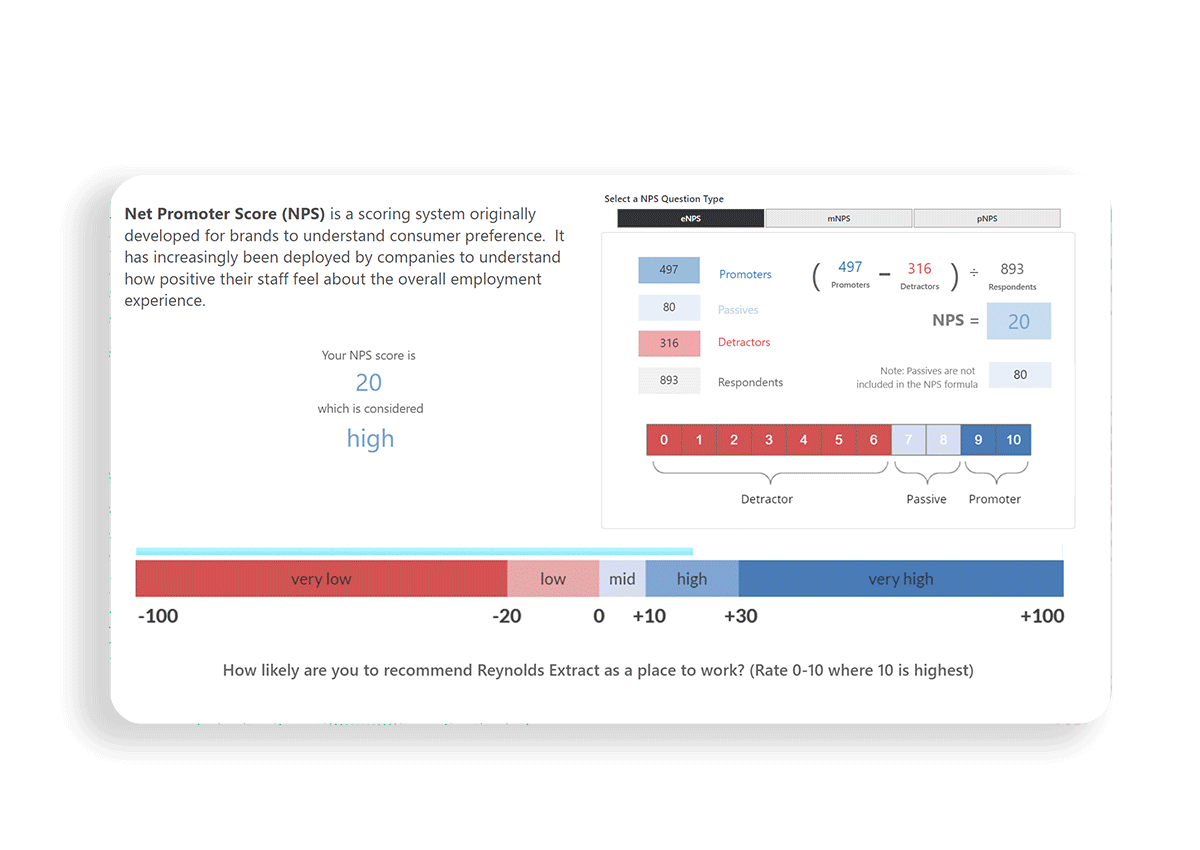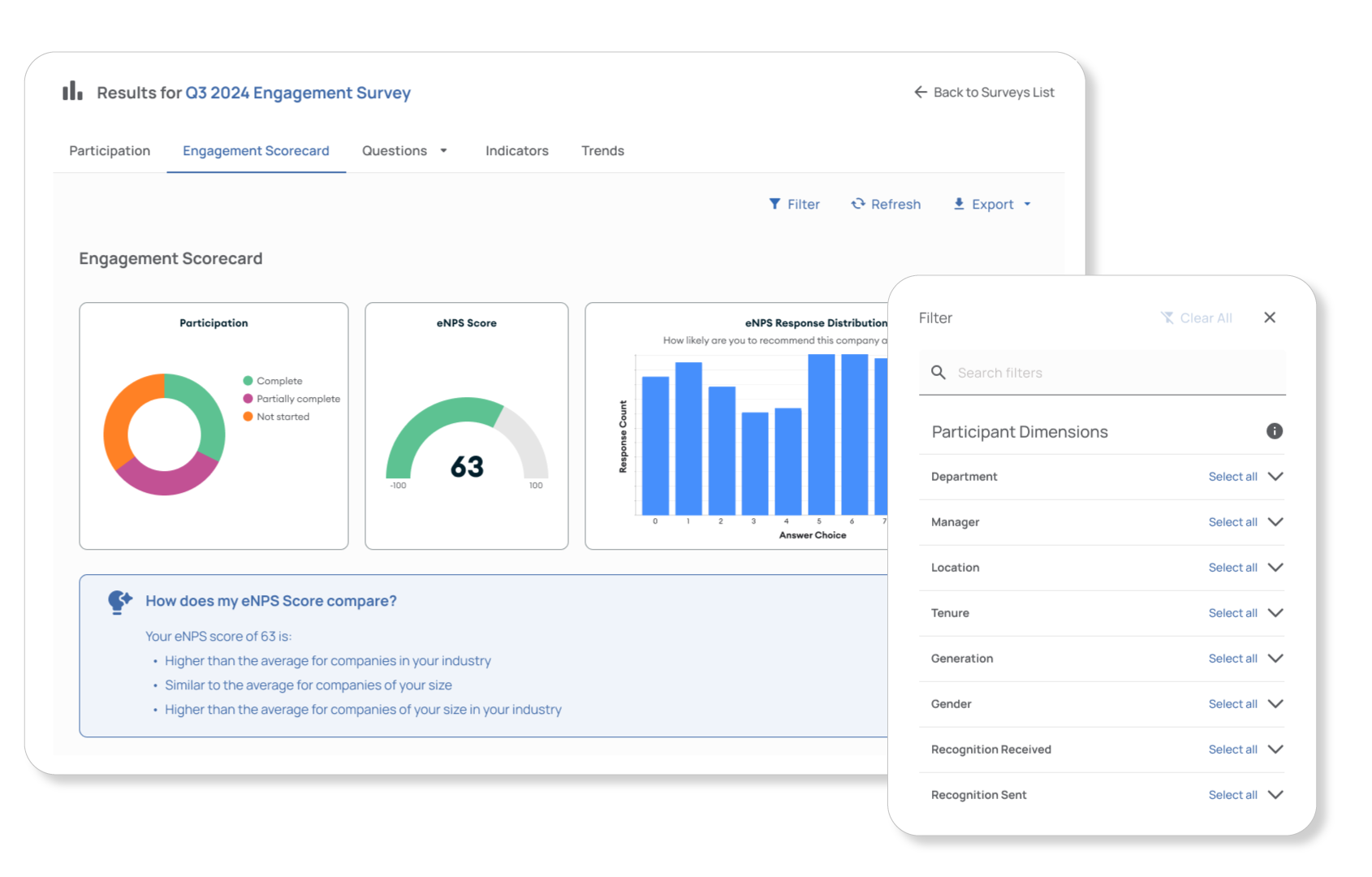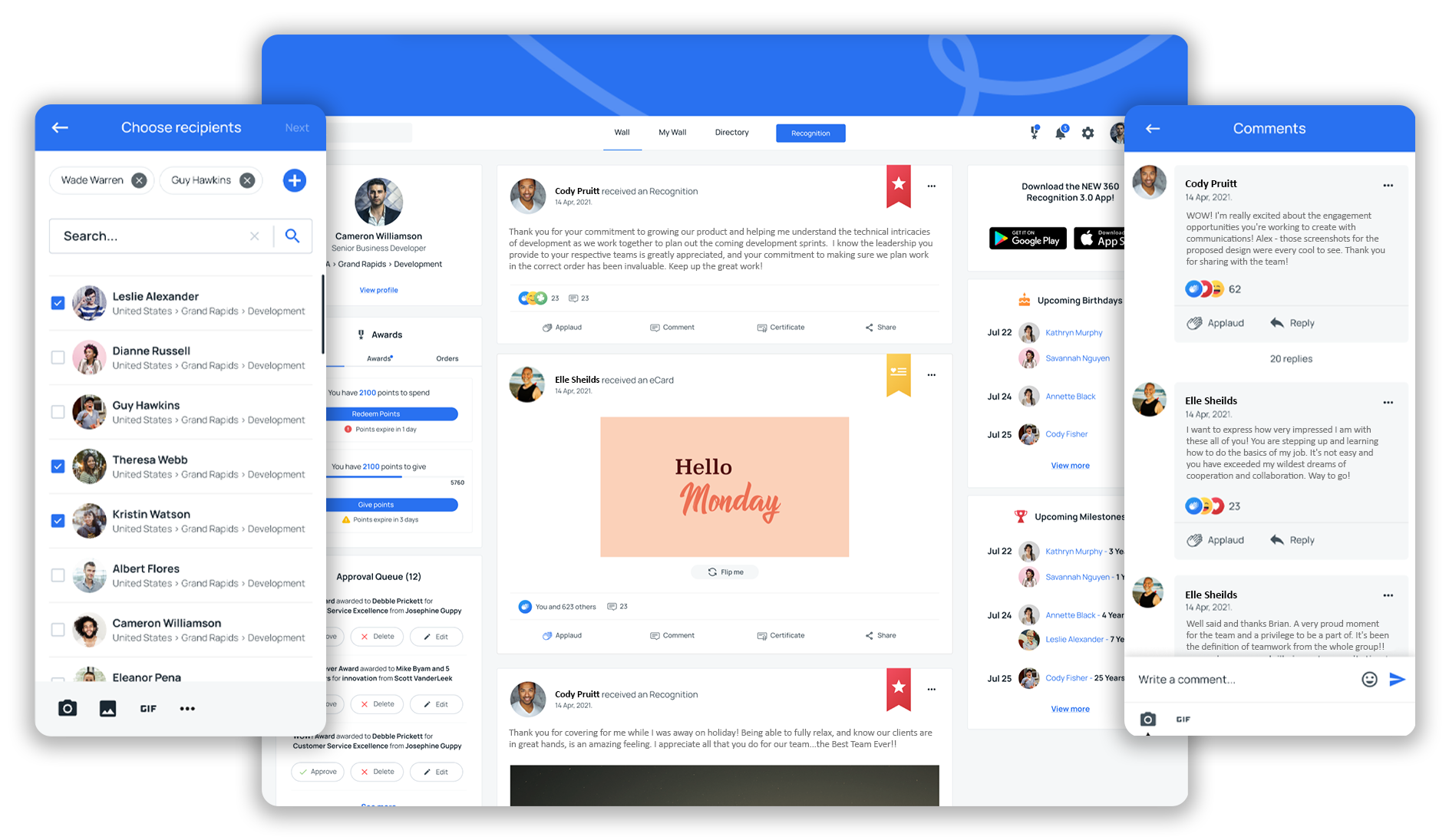June 2, 2025

As employee disengagement has continued to climb steadily over the past few years, employee engagement has emerged as a crucial driver of organizational success. So much so, Gallup has said that we’re in a “global engagement crisis.”
Engaged employees are not only more productive but also more loyal, innovative, and invested in the company’s mission. As businesses recognize the significance of employee engagement, measuring it through various metrics has become essential. However, engagement measurement presents unique challenges, as accurately assessing how engaged employees are within an organization requires careful consideration of both qualitative and quantitative factors.
Here, we’ll discuss the world of employee engagement metrics, understanding what they are, why they matter, and which ones companies should focus on for fostering a thriving workplace, including how quantitative data can inform decisions.
What are Employee Engagement Metrics?
Employee engagement metrics are quantifiable data points used to assess the level of emotional commitment, motivation, and connection that employees have with their work and the organization.
These metrics help organizations gauge the overall health of their workforce, identify areas for improvement, and tailor strategies to enhance employee satisfaction and performance. A few key metrics to track include voluntary turnover rate, absenteeism, employee satisfaction, and many more.
Companies typically track these areas through employee engagement surveys sent periodically throughout the year. Employee engagement measurement is crucial for understanding workforce health and making informed decisions to improve organizational outcomes.
Why are Employee Engagement Metrics Important?
It should be no surprise that tracking factors like these can play a critical role in not only improving employee engagement, but the overall performance of the company as well. Measuring employee engagement metrics is essential for identifying areas for improvement and driving organizational success.
In fact, tracking employee engagement metrics has been linked to a range of positive business outcomes. Including:
Improved Employee Retention
Tracking a range of employee engagement metrics helps leaders address potential issues early, before they spiral into deal-breakers for employees. This can, in turn, help reduce voluntary employee turnover and improve the employee retention rate. Monitoring a high employee turnover rate is crucial, as it can signal underlying engagement or management issues that need to be addressed.
Better Leadership
Depending on the questions asked in your survey, leaders can gain insights into areas they do well and which areas need improvement. This can help managers learn how to best meet the needs of their team, ultimately resulting in more effective leadership and higher employee engagement. Facilitating meaningful conversations between managers and employees encourages honest feedback and leads to better engagement outcomes.
Increased Engagement Levels
Ultimately, the goal when tracking engagement metrics is to improve employee engagement and job satisfaction. Being able to track this allows leaders to tap into early signs of burnout, dissatisfaction, and disengagement and address it early. Identifying low engagement is crucial for preventing further organizational issues that can arise from decreased employee involvement and motivation.
Improved Productivity
Highly engaged employees naturally tend to be more productive and motivated, and productive employees contribute significantly to organizational success. They’re more likely to invest extra effort, leading to increased productivity and higher quality work. When employees are emotionally invested in their roles, they tend to be more focused, creative, and motivated to contribute their best.
Improved Company Culture
Tracking employee engagement metrics will offer insights into how employees feel about company culture. Culture is an often overlooked aspect of employee engagement, although it plays a critical role. Engagement metrics can help assess whether the company's culture aligns with employee values and expectations. In fact, research has found that a healthy work culture is 10 times more important to employees than pay.
Better Customer Service
Engaged employees are more likely to provide excellent customer service, as their enthusiasm and commitment extend to interactions with clients and customers. This, in turn, can improve client retention and revenue.
Measuring customer satisfaction is important for assessing the impact of employee engagement on customer experiences, as it helps determine how well service quality meets or exceeds expectations. Low customer satisfaction can often be traced back to low employee engagement, highlighting the strong connection between employee morale and the overall customer experience.
2 Ways to Measure Employee Engagement

Measuring employee engagement is essential for organizations that want to foster a motivated, committed, and high-performing workforce. By systematically assessing how employees feel about their roles, their teams, and the company as a whole, organizations can gain a clear understanding of employee satisfaction and identify opportunities for growth.
Effective measurement of employee engagement not only highlights areas where employees are thriving but also uncovers pain points that may be holding back business success. With the right approach, organizations can use these insights to develop targeted strategies that boost engagement, enhance employee satisfaction, and drive long-term business success.
1. Employee Surveys and Feedback
Employee surveys and feedback mechanisms are among the most effective ways of measuring employee engagement. These tools give employees a voice, allowing them to share their honest opinions about their experiences at work.
By regularly conducting employee surveys, organizations can gather valuable insights into what’s working well and where improvements are needed. Tracking engagement trends over time helps HR leaders and managers identify patterns, monitor the impact of engagement initiatives, and make informed decisions to improve the workplace.
To maximize the effectiveness of employee surveys, it’s important to keep them concise, focused, and actionable—this helps prevent survey fatigue and ensures employees feel their feedback is valued and acted upon. When employees feel heard, they are more likely to stay engaged and contribute positively to the organization.
2. Annual Engagement Surveys
Annual engagement surveys are a cornerstone of measuring employee engagement in many organizations. These comprehensive surveys typically cover a broad range of topics, from job satisfaction and employee recognition to company culture and employee retention.
By conducting annual engagement surveys, organizations can establish a baseline for engagement levels, track changes year over year, and identify long-term trends that impact the employee experience. The insights gained from these surveys can inform strategies to improve employee engagement, strengthen company culture, and enhance employee retention.
However, relying solely on annual surveys may not capture the full picture—supplementing them with pulse surveys and other feedback tools throughout the year provides more frequent, real-time insights. This balanced approach ensures organizations can respond quickly to emerging issues and continuously improve engagement levels.
9 Employee Engagement Metrics You Should Be Tracking
Because there’s no one single metric that gives a full picture of your corporate environment, it’s important to measure a range of metrics. Measuring engagement using various tools and methods, such as surveys and data-driven analytics, is essential to accurately assess employee involvement and satisfaction. To measure employee engagement, build your survey with a holistic approach in mind.
Below, we outline important employee engagement metrics every company should track. Organizations can track engagement over time to identify trends and areas for improvement.
1. Employee Net Promoter Score (eNPS)
You’ve likely heard of a net promoter score (NPS), but an employee net promoter score (eNPS) is slightly different. Similar to the NPS used for customer loyalty, eNPS measures how likely employees are to recommend the company as a place to work. It offers insights into overall employee satisfaction and loyalty. To measure employee satisfaction more comprehensively, eNPS can be used alongside an employee satisfaction survey, allowing organizations to analyze both quantitative and qualitative feedback and gain deeper insights into factors affecting satisfaction.
Based on your employee feedback, you’ll likely find three types of employees: Promoters, passives, and detractors. Promoters respond to this question with either a 9 or 10 and indicate high satisfaction. Passives tend to rate a 7 or 8 for this question, indicating a relatively neutral sentiment. Detractors rate this question as a 6 or lower, indicating they are unhappy or unsatisfied within their company.
From here, you can determine your overall eNPS by subtracting your percentage of detractors from your percentage of promoters. Therefore, in theory, a company could have an eNPS anywhere from +100, where everyone in your company is a promoter, to -100, where everyone in your company is a detractor.
It’s generally believed that a good eNPS score ranges between +10 and +30. An employee net promoter score is a great way to transform employee sentiment into trackable data.
Example eNPS Survey Questions:
- How likely are you to recommend [company] as a place to work?
- What can we do better as an employer to improve your experience?
- Why would you not recommend our company as an employer?
- What’s one thing we can improve that could enhance your experience with our company?
2. Voluntary Employee Turnover Rate

As every HR manager or leader knows, employee turnover is an expensive problem to have. In fact, it’s estimated that the cost of replacing an individual employee can range from one-half to two times the employee’s annual salary.
Furthermore, recent research suggests that quitting is contagious. A study from The Wall Street Journal found that for every five employees who quit, another employee left the company within six months. They also found that high performers tended to follow other high performers out the door, and low performers tended to do the same. Retaining the highest-engaged employees is essential for maintaining productivity and positive business outcomes, as these employees contribute significantly to organizational success.
But beyond expense, voluntary turnover is a symptom of a bigger problem. Highly engaged employees are less likely to quit, therefore, a high turnover rate can indicate an employee engagement issue. Additionally, highly engaged employees can leave due to poor management, toxic cultures, or better pay.
So, it’s important to track the voluntary turnover rate as an indicator for many facets of company health.
Calculate the voluntary turnover rate by taking the number of employees who left voluntarily in a given period and dividing it by the total number of employees you had in that same period. Then multiply by 100 to get a percentage. Keep in mind that, as a general rule, companies should aim for a turnover rate of 10% or less.
3. Retention Rate
Converse to the employee turnover rate, companies can track their employee retention rate as a way to help measure employee engagement.
Retaining employees is not only cost-effective, but it’s good for morale and can be a sign of a healthy, engaged workforce. High retention rates often reflect strong workplace satisfaction among employees.
To calculate the retention rate, subtract the total number of employees who left from the total number of employees. Then, divide that number by the total number of employees. Multiply this by 100 to get the retention rate percentage.
Aiming for a retention rate of 90% or higher is ideal.
4. Absenteeism
Absenteeism in the workplace refers to excessive absences that are unplanned and/or unannounced. This may also include lateness, early departures, and/or extended breaks. On the surface, absenteeism may sound like an engagement issue - disengaged employees feel more likely to miss work or take a long lunch.
However, it’s important to dive a bit deeper if absenteeism is an issue at your company. This is because you may find disengagement isn’t the problem at all, but rather childcare challenges, mental health, or harassment are more prevalent issues causing absenteeism.
In fact, according to the National Institute of Mental Health, the leading cause of absenteeism in the United States is depression. Depression can make it difficult for individuals to get out of bed, stay motivated, and engage in work. Furthermore, A report by Blue Cross Blue Shield found that depression diagnoses are rising at a faster rate for millennials and teens than for any other generation.
So, rather than simply tracking your absentee rate, get employee feedback about the reasons why they might miss work unexpectedly as well. Monitoring your employee absenteeism rate can help you identify high employee absenteeism and uncover underlying organizational issues that may be affecting workplace satisfaction and engagement.
5. Work Culture

A healthy work culture has arguably never been more important than it is today. Recent research has shown that a healthy work culture is 10 times more important to employees than pay, 66% of employees believe positive cultures impact their work for the better every day, and a toxic workplace culture was cited as the top reason employees quit in 2022.
So, any company that’s measuring employee engagement should be sure to include metrics specifically addressing culture. Surveys and feedback tools can help capture employees experiences with the company's culture, providing valuable insights into how employees feel and engage at work.
Example Company Culture Survey Questions:
- Do you feel a sense of belonging at work?
- Do you feel recognized and appreciated for your work?
- How often do you feel the need to come in early and/or work late?
- How often do you feel pressured to not take breaks or not take your full break?
- Have you ever felt reluctant or scared to use PTO or sick days?
- How often do you feel the need to do calls, emails, or IMs after hours and/or on weekends?
- Do you feel pressure to “keep up” or an inability to say no or set boundaries around the work asked of you?
6. Recognition and Appreciation
Employee recognition is one of the the simplest yet effective ways to create engaged employees. So much so, some studies have found that when employees believe they’ll be recognized for their work, they’re nearly 3 times more likely to be highly engaged in their work.
Additionally, recognition can be even more impactful than money. Global practice leader, Anita Bowness, from Halogen Software said in a Forbes article, “Providing recognition in front of a person’s peers and executives, or a handwritten ‘thank you,’ can have a longer lasting motivational effect on an employee than money.”
So, whether you have a formal recognition program complete with social recognition, service awards, and SWAG - or you have an informal program based on simply saying thank you often, your employees need to feel appreciated. This means tracking recognition is critical for measuring employee engagement. Regular recognition can also boost employee morale and contribute to a positive workplace environment.
Tracking the frequency and quality of employee recognition and feedback processes can shed light on the level of appreciation and communication within the organization.
Example Employee Appreciation Survey Questions:
- Do you feel appreciated at work?
- Do you feel valued at work?
- Are you satisfied with the amount of recognition you receive?
- Do you think [company] recognizes people for the right things?
- Do you feel recognized in a way that resonates with you?
7. Career Growth and Development
Another key employee engagement metric to cover in employee engagement surveys is whether or not your employees believe they have room to grow in their careers. Although there have been trends like quiet quitting, which imply professional development isn’t important to employees, research has shown otherwise.
According to Pew Research, a lack of opportunities for advancement is one of the top reasons people quit their jobs in 2022. Career growth is directly tied to employees’ sense of autonomy - a critical aspect of occupational wellness. Performance metrics can be used to track progress and identify opportunities for career advancement, helping both employees and organizations measure growth effectively.
Additionally, career growth and development are especially true for younger employees. According to a LinkedIn study, 40% of young workers said they were willing to accept a 5% pay cut to work in a position that offered career growth opportunities. Additionally, 76% of Gen Zers want more opportunities to move up or increase responsibilities at work.
Example Career Growth Survey Questions:
- I feel that I’m growing professionally.
- What can our company do to help you grow professionally?
- I have the opportunity to do challenging things at work.
- I see a path for me to advance my career in our organization.
- What are your career goals within our organization?
- Most days I feel a sense of accomplishment from what I do.
- My role is aligns with my strengths.
8. Compensation and Benefits
It’s untenable that compensation matters. At the end of the day, the most engaged employee will leave if they can’t afford groceries or to go to the doctor. Furthermore, employees are becoming less likely to settle for less than their worth today, too.
According to a survey from Bankrate, 42% of Gen Z workers and 40% of millennial workers have shared their salary information with coworkers. This means that younger employees are more likely to recognize a pay gap. This can lead to feelings of resentment, hinder job satisfaction, cause disengagement, and even lead to turnover.
Unfortunately, job switching has been shown to be an effective way to receive a raise, too. One survey found that 49% of people who switched jobs during the pandemic received a 10% or more pay increase. Furthermore, it found that 62% of people are concerned that their salary won’t keep pace with inflation.
So, leaders who want to retain their top talent should be sure to include questions about compensation when considering employee satisfaction and overall employee engagement. Compensation and benefits are key engagement metrics that can significantly influence both retention and satisfaction.
Example Compensation Survey Questions:
- How would you rate your current salary?
- Do you feel fairly compensated?
- Do you have concerns about [company’s] pay structure?
- How would you rate [company’s] benefits overall?
- How satisfied are you with [company’s] health insurance benefits?
- Do you have concerns about [company’s] benefits package?
9. Management/Leadership

Managers play an important role in fostering employee engagement. Understanding employee engagement allows leaders to tailor their management approach to better support their teams and address specific needs. A good leader can inspire their team to innovate, collaborate, and help employees reach their full potential. On the other hand, an ineffective leader can demotivate, stifle creativity and confidence, and cause poor employee satisfaction.
Furthermore, a boss who is ineffective can come across as unpredictable to many subordinates. Employees may feel that they have to walk on eggshells around their manager, which can lead to chronic stress at work. These prolonged feelings of stress, self-doubt, and constant criticism can negatively impact an employee’s mental health outside of work. It’s not uncommon for ineffective management to contribute to mental health issues such as depression, anxiety, sleep problems, and fatigue.
Unfortunately, studies suggest poor leadership isn’t uncommon. A survey conducted by Trinity Solutions found as many as 79% of people have experienced micromanagement. And of the people who reported working for a micromanager, 85% said it had decreased their morale and 71% said micromanagement interfered with their job performance.
Therefore, taking a look at employee feedback regarding their managers and leaders can be beneficial for both future and current employees.
Example Leadership Survey Questions:
- Does management clearly communicate their expectations?
- Does your manager effectively communicate the information you need to understand?
- Do you feel that your manager cares about your professional development?
- Does management explain the reasons behind decisions made?
- Does your manager explain how the organization’s future plans affect you?
- Do you feel heard and valued?
- How frequently do you receive recognition from your manager?
Engagement Trends and Insights
Understanding engagement trends and insights is key to building and maintaining an engaged workforce. By analyzing data from employee surveys, feedback sessions, and other engagement metrics, organizations can uncover the underlying factors that drive employee engagement—such as employee recognition, work-life balance, and a positive company culture.
By staying attuned to engagement data and acting on valuable insights, companies can create a thriving workplace culture that supports employee retention, satisfaction, and long-term success.
Measure employee engagement with Terryberry. We partner with organizations and help build employee satisfaction and an engaged workforce through a multifaceted employee engagement platform. Our platform includes:
- Social Recognition: Empower your employees and managers to recognize their peers and celebrate successes with an easy-to-use social recognition application, with engagement survey capabilities built-in.
- Service Awards and Performance Awards: Recognize and reward employees based on years of service awards, anniversaries, or performance.
- Wellness Programs: We make it easy to run wellness programs and activity challenges that increase engagement, expand corporate health, and build team camaraderie.
Ready to learn more? Schedule a demo with our team to get a hands-on walkthrough of how Terryberry can increase employee engagement at your workplace.



